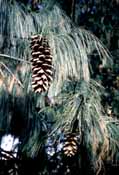 Foliage and cones on a tree in the Vancouver (Canada) Botanical Garden [C.J. Earle, 7-Feb-1998]. | Pinus wallichiana JacksonCommon NamesBhutan pine, Himalayan white pine (1).Taxonomic notesSyn: P. excelsa Wall.; P. griffithii McClelland; P. chylla Lodd. (1).DescriptionTree to 50+ m tall with straight trunk and short, downcurved branches. Branches longer in solitary trees, creating a dome-like crown. Bark on young trees smooth, becoming fissured with age. Branches in regularly spaced whorls, smooth. Young shoots glaucous, later turning pale grey-green, smooth, ribbed, darkening with age. Winter buds grey with an orange tinge, ovoid-conic, pointed. Leaves in fascicles of 5, basal sheaths deciduous, 15-20 cm long, often curved at the base, slender, flexible, abaxial side green, adaxial side with multiple bluish-white stomatal lines; usually pendant but in some trees spreading. Male strobili on lower branches, often in dense clusters on younger twigs. Female cones in groups of 1-6, 20-30 cm long, erect when young but later pendant [see photo], bluish-green when young, maturing to light brown with pale brown apophyses. Cone scales wedge-shaped, wide near the apex, apophysis grooved, ending in a blunt umbo; basal scales usually not, or only slightly, reflexed, very resinous (1).RangeHimal: southern flank, from Afghanistan through Pakistan, India, Tibet (China: Xizang), Nepal and Bhutan to Burma. Found in valleys and foothills at elevations of up to 3400 m (in Bhutan), sometimes in pure stands but often in association with broadleved species of Quercus, Acer and Ilex. In the western Himal it forms mixed stands with Cedrus deodara. It may also be associated with the more narrowly distributed pines Pinus khasya and P. roxburghii. It is shade-intolerant, thus early seral (1).Big TreeOldestDendrochronologyEthnobotanyObservationsRemarksCitations(1) Farjon 1984. |
[Pinus] [Pinaceae] [home] This page is from the Gymnosperm Database |